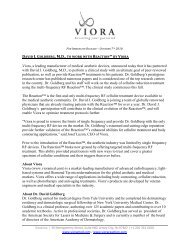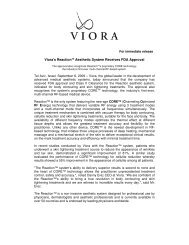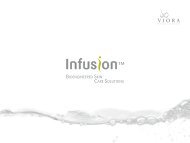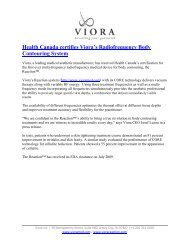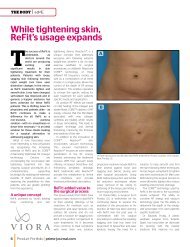read more - Viora
read more - Viora
read more - Viora
You also want an ePaper? Increase the reach of your titles
YUMPU automatically turns print PDFs into web optimized ePapers that Google loves.
Introduction<br />
Acne Clearance Treatments with Trios <br />
Three Month Follow-Up Study<br />
Smadar Schreiber, M.D.<br />
ABSTRACT: The following study evaluates the Trios Intense Pulsed Light (IPL) system for the application of Acne Clearance. Twenty three<br />
patients with mild to moderate acne, underwent two treatments per week for 4 weeks using the Trios Acne Clearance applicator with a<br />
wavelength of 400-1200nm. Average fluence of pulses was 5J/cm 2 with pulse duration of 25 msec. At 3 months evaluation follow up 83% of<br />
the patients experienced significant clearance (> 75%) while 17% demonstrated moderate clearance (50% - 75%) compared to baseline.<br />
Overall average clearance of acne lesions was 88.83%. Patients also showed visible improvement in skin texture, tone and complexion. No<br />
adverse effects were reported, except for mild and transient erythema.<br />
Acne Vulgaris is an exceedingly common chronic skin disorder<br />
that affects approximately 40 million adolescents in the U.S. alone<br />
and comprises <strong>more</strong> than 30% of all dermatological visits (1)(2) . The<br />
disorder is localized to skin regions with a high number of sebaceous<br />
follicles such as the face, back and chest (3) . Acne Vulgaris may lead<br />
to long-term scarring and disfigurement, and often contributes to a<br />
state of psychological distress, social withdrawal, clinical depression<br />
and even suicide (4) .<br />
Propionibacterium acne (P. acnes), responsible for the outbreak<br />
of inflammatory acne produce and accumulate endogenous<br />
porphyrins (namely protoporphyrin, uroporphyrin, and<br />
coproporphyrin III) which are the target chromophores for the<br />
acne clearance application (5)(6) . Light-based therapy for acne was<br />
introduced a decade ago and has become an accepted modality<br />
in the armamentarium of acne treatments.<br />
Exposure of inflammatory acne lesions to light utilizing blue,<br />
green and red wavelengths which are absorbed by the porphyrins<br />
induces a photochemical reaction which generates highly reactive,<br />
free radical singlet oxygen that subsequently causes bacterial<br />
destruction (7) .<br />
The IPL acne phototherapy technique thus relies on a combination<br />
of photochemical and photothermal mechanisms of action. The<br />
wide spectral range of wavelengths optimizes the trade-off between<br />
penetration depth and porphyrin activation efficiency. Blue light<br />
(415-420nm) gives the strongest porphyrin photoactivation but<br />
poorly penetrates into human skin, whereas green and red lights,<br />
although less effective in photoactivation, have an increased depth<br />
of penetration into human skin that contributes to the stimulation<br />
of cytokine that is released from macrophages and induces an antiinflammatory<br />
response (8)(9) .<br />
Materials and Methods<br />
Twenty three patients between the ages of 15-29 years, with mild<br />
to moderate facial acne, underwent two treatments per week for<br />
4 weeks using the Trios acne clearance applicator, which emits<br />
wavelengths from 400 to1200nm. During the treatment 30-55<br />
pulses of 5J/cm 2 at 25 msec duration were applied, covering the<br />
entire treatment area with no <strong>more</strong> than 30% overlap. After the<br />
completion of the above treatment schedule, evaluations were<br />
held once a month for three consecutive months. Photographs of<br />
the treated areas were taken at baseline, post treatments 2, 4, 6<br />
and 8, and at each of the three monthly evaluation visits. Lesions<br />
were counted using these photographs.<br />
At the same time patients were requested to assess treatment<br />
results and progress using the scale below:<br />
0 - No improvement (< 25%)<br />
1 - Mild improvement (25%-50%)<br />
2 - Moderate improvement (50%-75%)<br />
3 - Significant improvement (>75%)<br />
Results<br />
All patients completed the treatment course and underwent<br />
monthly evaluation follow-ups for 3 months following the last<br />
treatment. Moreover, all patients reported good response to the<br />
treatment.<br />
At the third monthly follow up visit 83% (19/23) of the patients<br />
demonstrated significant clearance (>75%) compared with<br />
baseline (see Figures 1 and 3). The rest of the patients, 17% (4/23),<br />
demonstrated moderate clearance (~66%) and underwent two<br />
additional treatments post third follow up visit. At the end of<br />
the treatment course and the three follow up visits an average<br />
clearance of 88.83% was recorded for all 23 patients (see Figures<br />
1 and 3).<br />
In 78% (18/23) of the patients, improvement was consistent<br />
throughout the study period. Interestingly enough, the patients'<br />
assessments correlated with the actual acne lesion counts; 87%<br />
(20/23) assessed the improvement as significant and 13% (3/23)<br />
assessed the improvement as moderate. In all patients, a dramatic<br />
improvement in skin texture, tone and complexion was also<br />
visible.<br />
With the exception of transient mild erythema, no adverse effects<br />
were reported and all patients completed the treatment course<br />
and underwent monthly evaluation follow ups for 3 months<br />
following the last treatment. Moreover, all patients reported good<br />
response to the treatment.<br />
Figure 1 – Percentage of acne clearance<br />
© 2009 <strong>Viora</strong> Ltd.
Before<br />
Figure 2 – Before and after of acne clearance treatment<br />
Post 8 treatments<br />
Discussion<br />
The results of this study confirm that treatment of Acne Vulgaris with the Trios IPL system is an effective and safe application. At the<br />
conclusion of the study an average improvement of 88.83% was recorded. Improvement rate was consistent throughout the study for the<br />
majority of patients (78%). In some cases a withdrawal was recorded (only post 4 treatments), however at the conclusion of the study, 4<br />
out of 5 of these patients also showed a significant improvement in their condition. No adverse effects were reported, except for mild and<br />
transient erythema. In addition, all patients demonstrated an improvement in skin texture and quality. The results of this study indicate that<br />
treatment with the Trios IPL system hinders development of acne lesions and that results are sustainable over time.<br />
Post 2tx Post 4tx Post 6tx Post 8tx Post third follow-up<br />
Patient No. Sex Baseline* Count Average<br />
clearance %<br />
Count<br />
Average<br />
clearance %<br />
Count<br />
Average<br />
clearance %<br />
Count<br />
Average<br />
clearance %<br />
Count<br />
Average<br />
clearance %<br />
1 M 34 34 0 26 24 21 38 14 59 3 91<br />
2 M 73 51 30 47 36 36 51 27 63 19 74<br />
3 F 22 24 -9 24 -9 23 -5 10 55 2 91<br />
4 F 37 38 -3 30 19 25 32 13 65 1 97<br />
5 F 63 52 17 41 35 37 41 28 56 21 67<br />
6 M 19 20 -5 18 5 16 16 7 63 2 89<br />
7 F 33 30 8 25 24 22 33 11 67 5 85<br />
8 M 31 25 19 22 29 18 42 10 68 1 97<br />
9 F 44 37 16 36 18 29 34 21 52 0 100<br />
10 M 18 16 11 21 -17 18 0 11 39 8 56<br />
11 F 39 35 10 34 13 27 31 13 67 4 90<br />
12 M 58 54 7 50 14 42 28 27 53 3 95<br />
13 F 44 38 14 31 30 26 41 18 59 1 98<br />
14 F 61 50 18 43 30 28 54 27 56 4 93<br />
15 F 21 23 -10 18 14 14 33 8 62 0 100<br />
16 M 55 47 15 36 35 31 44 17 69 5 91<br />
17 F 46 37 20 33 28 25 46 13 72 2 96<br />
18 M 23 22 5 16 30 13 43 5 78 3 87<br />
19 F 45 41 10 35 22 27 40 18 60 14 69<br />
20 M 32 27 16 24 25 21 34 20 38 3 91<br />
21 M 54 40 26 39 28 30 44 23 57 1 98<br />
22 F 71 53 25 51 28 38 46 20 72 5 93<br />
23 F 29 17 41 15 48 13 55 7 76 1 97<br />
12.21% 22.11% 35.79% 61.05% 88.83%<br />
Figure 3- Lesion counts in 23 patients.<br />
* Data indicated in the table relates to the third follow up visit.<br />
1. Leyden JJ, Acne vulgaris is a multifactorial disease. J Am Acad Dermatol 2003; 49 (3 Suppl); S199<br />
2. Leyden JJ, Therapy for acne vulgaris. N Engl J med 336:1156-1162<br />
3. Leyden JJ, et al., Age related changes in the resident bacterial flora of the human face. J invest Dermatol 1975; 65; 379-381<br />
4. Mulder MM et al., Evaluation of the relation between the a change in clinical acne severity and psychosocial state. Dermatology 2001; 203;124-130<br />
5. Lee WL, et al., Comparative studies of porphyrin production in Proponibacterium acnes and Proponibacterium granulosm. J Bacteriol 1978; 133;811-815<br />
6. Ashkenazi H, et al., Eradication of Proponibacterium acnes by its endigenic porphyrins after illumination with high intensity blue light. FEMS Immunol Med Microbiol 2003;35:17-24<br />
7. Mariwalla K, Rohrer TE. Use of lasers and light-based therapies for treatment of acne vulgaris. Lasers Surg. Med. 37:333-342, 2005.<br />
8. Sigurdsson V, et al., Pototherapy of acne vulgaris with visble light. Dermatology 1997:194:256-260.<br />
9. Young S, et al., Macrophage responsiveness to light therapy. Laser Surg Med 1989;9:497-505.<br />
© 2009 <strong>Viora</strong> Ltd.




